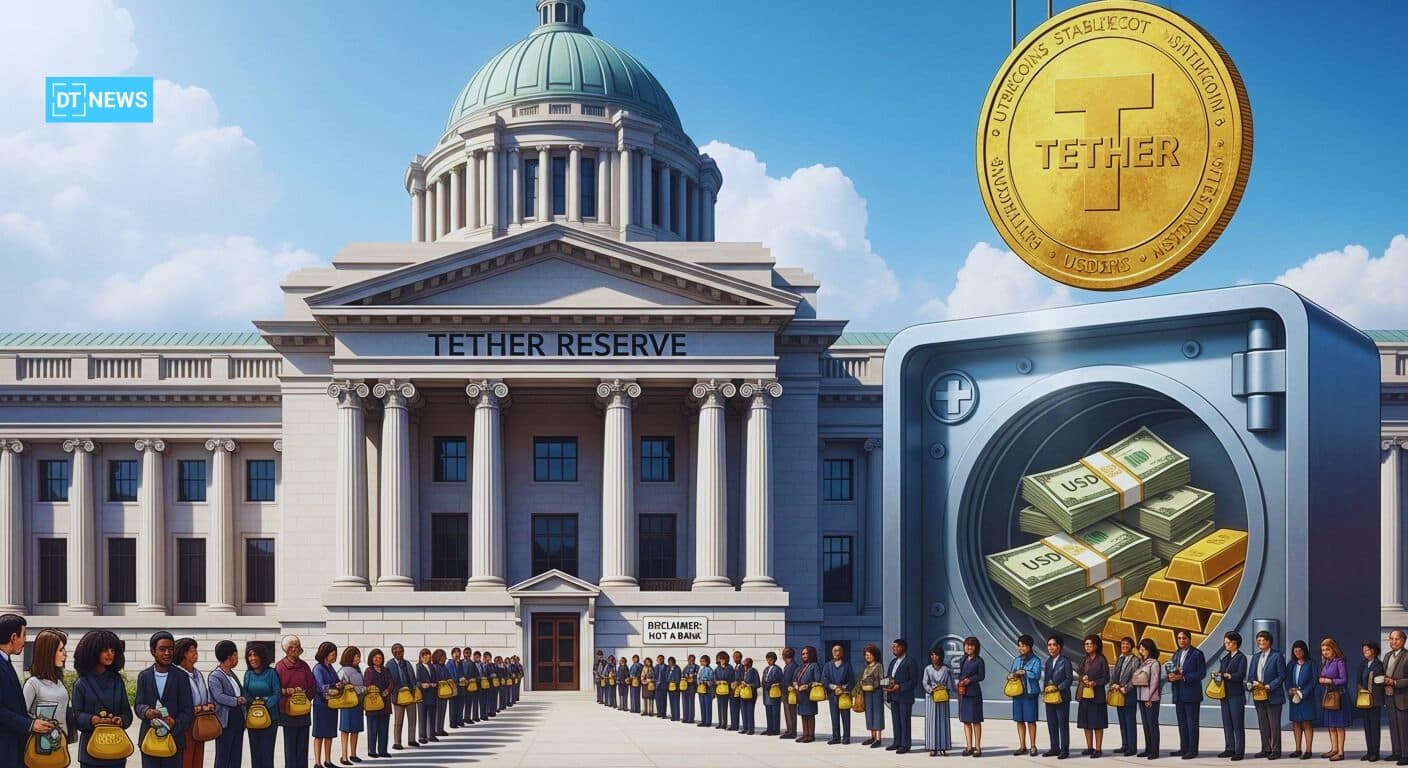This article was first published by Deythere.
Tether, the issuer of the USDT dollar-pegged stablecoin, has built a giant financial empire. Its Q3 2025 attestation shows $181.2 billion in reserves backing $174.4 billion in liabilities, leaving $6.8 billion in excess reserves.
With high interest rates, Tether’s U.S. Treasury holdings turned into $10 billion in profit for 2025.
That’s enough to set Tether apart from regular startups. In fact, many now call it a “Tether central bank” because its operations, balance sheet and policies look more like a national monetary authority than a simple stablecoin issuer.
Tether’s Growing Balance Sheet and Reserves
Tether’s latest attestation shows a $181.2B reserve base, including Treasuries, gold and Bitcoin. This massive portfolio, combined with record-high interest rates, generated over $10B in profit in 2025 alone. Tether earns “seigniorage” (interest) from its reserves while USDT holders earn nothing, a practice very much like a central bank earning interest from currency issuance.
Cointelegraph reports that Tether’s “Treasury-heavy portfolio” made over $10B in 2025, a level of profit more typical of a sovereign monetary authority than a crypto startup.
Tether’s scale and profits are now reportedly bigger than what is expected from a regular stablecoin. So commentators now call Tether a private, dollar-linked central bank for part of the crypto economy. We’ll get into those comparisons.

Tether’s public attestations (third-party audits of its books) show a balance sheet composed mostly of short-term government debt and other liquid assets.
As of Sept 2025, the company had $181.2B in total reserves backing $174.4B in USDT. These reserves include: U.S. Treasuries ($135.0B), 12.9B in gold, 9.9B in Bitcoin, $14.6B in secured loans, and smaller holdings in other investments. This is like a central bank’s reserve portfolio of bonds and commodities, not a crypto startup’s cash drawer.
Table: Composition of Tether’s $181.2 B reserves (Q3 2025).
Here’s Tether’s reserves (Q3 2025):
| Reserve Asset | Amount (Q3 2025) |
| U.S. Treasuries | $135.0 B |
| Gold | $12.9 B |
| Bitcoin | $9.9 B |
| Secured Loans | $14.6 B |
| Other Investments | $3.9 B |
| Corporate Bonds | $0.015 B |
| Total | $181.2 B |
With that kind of portfolio, Tether is one of the top holders of US debt. CEO Paolo Ardoino said Tether is “the 17th largest holder of US debt” with $135B in Treasuries. And that interest income on those Treasuries and other assets has turned into $10B in profit in 2025.
That’s unheard of for a stablecoin issuer hence the analogy to central banks.
Tether’s balance sheet growth also affects crypto liquidity. Issuing or redeeming USDT changes how much dollar liquidity is in the market, just like a central bank expanding or contracting a currency supply.
Daily USDT trading volume is in the tens of billions, it’s the “backbone of liquidity” in crypto. For context, by mid 2025, the global stablecoin market was around $300B (with USDT the largest share).
As a result, Tether’s size and holdings are now rivaling some small central banks’ balance sheets.
Issuance, Redemption and Seigniorage
A central bank mints and redeems currency; so does Tether, just in a different system. Verified institutions can create USDT by depositing USD (or other fiat) with Tether and redeem USDT 1:1 back to USD.
This primary market action expands or contracts USDT supply on demand. Meanwhile, secondary market trading on crypto exchanges lets anyone buy or sell USDT, but ultimate redemption is centrally managed.
Tether’s mint-and-burn process means it controls the money supply of USDT, just like a central bank prints or withdraws bills.
The analogy goes even deeper when profit or “seigniorage” are looked at. A traditional central bank earns seigniorage by issuing non-interest currency and investing in interest-bearing securities. Tether does the same, issues non-interest USDT tokens and parks its reserves in Treasuries and other yields.
The interest on those reserves is Tether’s profit. As CoinTelegraph notes, users hold a non-interest-bearing token, while Tether collects interest on T-bills, resulting in more than $10B in profit and $6.8B in excess reserves as of Q3 2025.
In simpler terms, Tether takes in USDT from users and then uses that money to earn interest; a classic seigniorage model that in this high-rate environment is rivaling a bank’s income.
Similarities:
Issuance and Redemption: Tether expands/contracts USDT on demand, like a central bank managing currency supply.
Reserve Investments: Most of Tether’s reserves are in short-term Treasuries and repos, keeping liquidity while earning interest. This is like open-market operations.
Seigniorage: By holding interest-bearing assets against non-interest USDT, Tether earns a profit buffer (reported $10B+); just like central banks generate revenue from reserves.
Excess Reserves: Tether even has “excess reserves” ($6.8B) just like banks have extra liquidity.
These are not typical of a private company. In effect, Tether is issuing a digital dollar and earning as if it were a central bank. It mints USDT to meet demand, then locks that capital into yield-bearing assets.
Policy Tools and Market Influence
Beyond the balance sheet, Tether has policy-like powers over its ecosystem. Unlike decentralized coins, Tether can make top-down decisions. It can freeze addresses (e.g. sanctioned wallets) and even choose which blockchains will support USDT.
For example, Tether froze tens of millions of dollars worth of USDT held by Russian platform Garantex in 2023. It has also deprecated support for legacy USDT networks like Omni Layer, BCH- and EOS-based USDT and moved to newer chains.
These actions control who can move money and how fast, like a central bank changing regulations or closing currency corridors.
According to analysis, Tether’s interventions can impact dollar liquidity. By freezing accounts or changing networks, Tether gates its “dollars”.
In this sense, it has a compliance and security role like a public authority.
As sources note, these issuer-level levers are active intervention in a dollar-like asset used by hundreds of millions of people.
On the operations side, Tether’s reserve management is like an open-market tool. By holding very liquid assets (U.S. Treasuries, repos), Tether can honor redemptions at any time while influencing bond demand.
TipRanks notes that Tether’s buying of Treasuries adds steady demand for T-bills, which bond desks now track when they see a big buyer. In other words, Tether’s quarterly attested flow of billions into U.S. debt markets is effectively underwriting Treasuries, like a central bank supporting its own government’s bonds.
Tether also reinvests a portion of its profits into other assets. Notably, since 2023 it has dedicated up to 15% of operating profits to buying Bitcoin.
This policy, decided internally, adds another layer: Tether’s balance sheet decisions now move markets for crypto and gold. In total, Tether’s range of actions like freezing tokens, shifting networks, diversifying reserves, and redeploying profits makes it feel like a private policy-maker of its own dollar ecosystem.

Tether’s Gold and Asset Diversification
Tether has recently started to follow central banks’ strategy of holding gold. In 2025, it hired bullion traders from HSBC to grow its physical gold reserves. This is in line with a global trend of central banks buying gold, with over 1,000 tonnes added in 2024. Tether’s accumulation (now over 120 tonnes worth $12.9B) is largely following this path
Tether’s gold reserves have grown in 2025. According to Tether’s attestations, gold-backed tokens (XAU₮) represent about $12.9B of its reserves (over 100 metric tons). This private bullion hoard mirrors the central banks’ dash for gold. In effect, Tether is no longer just stacking dollars, it is also stacking gold.
Choosing gold and other non-cash assets is a long term hedge. Experts note this moves Tether away from pure dollar dependency. By holding hard assets, Tether is acting less like a payment processor and more like a sovereign wealth fund.
While this may give some investors more confidence, it also raises questions about audit and custody. Critics warn that without transparent audits, these large gold reserves will face the same scrutiny as Tether’s earlier (less public) backing for USDT.
In summary, Tether’s diversification into gold, Bitcoin and loans turns its reserve pool into a mini sovereign portfolio.
This broad asset mix managed by an internal “bullion desk” staffed by experienced traders, looks very much like a central bank building a basket of reserves.
Expert Insights and Analysis
Regulators and financial analysts are taking notice. For example, the U.S. Federal Reserve’s study group has noted that private stablecoins like USDT have redeemability on demand and backed by non-cash assets, making them inherently prone to run risk.
In plain terms, unlike bank deposits insured by the government, stablecoin issuers must convince the market they can always buy back coins for $1.
Tether’s huge reserves help, but experts warn it must maintain those liquid holdings to avoid a crisis.
Fed Governor Michael Barr says if asset values drop or liquidity dries up even fully backed stablecoins can lose their peg.
Indeed, USDT issuance has previously moved markets. Studies show Tether supply has often preceded Bitcoin rallies as Tether issuance floods exchanges with fiat equivalent cash.
The link between Tether printing and crypto prices gives it quasi-monetary power like a central bank’s actions ripple through the economy.
But unlike the Fed, Tether has no formal mandate to stabilize markets; it acts reactively to demand. As one analyst put it:
Regulators are trying to figure this out. In Europe, authorities have warned very large stablecoin systems can be systemic risks and are proposing (under MiCA) to ban multi-issuance models and require heavy guardrails.
Reuters news report notes the EU’s regulators fear “massive redemption requests” could trigger runs if a firm like Tether were under stress.
Conclusion
The core question is, When does a private stablecoin become “too big to fail”? Tether’s central bank-like scale suggests it may soon hit that threshold in crypto.
Experts agree Tether’s new role is unprecedented. It issues dollars, manages huge dollar reserves and sets policies internally but without oversight, transparency or backstop that a real central bank has.
This hybrid nature is why they say Tether is a private central bank without a mandate. Its performance and strategy might deserve scrutiny: can a private company be trusted with de facto money-issuance at this scale?
Glossary
Stablecoin: A cryptocurrency that’s pegged to a stable asset, like the US dollar. Stablecoins such as USDT are supposed to keep a 1:1 value with USD by hanging onto these physical reserves in the back end.
Central Bank: A national authority like the US Federal Reserve that gets to issue the currency, sets the monetary policy and looks after the reserves. The Fed for example uses its power to buy up government bonds in order to influence the amount of cash floating around.
Reserves: Stuff (cash, bonds, gold etc) that a currency is backed up by essentially the vault of assets that makes up the pile of cash in a bank account.
Seigniorage: The profit a currency issuer makes by just issuing it; for Tether this is the interest it gets on the reserves while USDT holders get nothing to show for it.
Redeemability: The promise that stablecoin holders get to swap their coins for actual dollars on demand.
Frequently Asked Questions About Tether Central Bank Role
What is Tether (USDT)?
Tether is a stablecoin, a cryptocurrency meant to stay near $1 in value. USDT is the most traded stablecoin, pegged 1:1 to the US dollar and issued by Tether Ltd. You trade it like dollars on crypto markets.
Is Tether’s reserves really that big?
Yes. According to its Q3 2025 attestation, Tether held about $181.2 billion in total reserves (mostly US Treasuries and other assets) against $174.4 billion of USDT in circulation. That leaves $6.8 billion in excess reserves.
Why do people say Tether acts like a central bank?
Because, unlike a simple startup, Tether issues and redeems currency on demand, invests huge reserves in safe assets, earns “seigniorage” (interest income) on those reserves and uses policy-style powers (like freezing addresses or funding Bitcoin). These traits are like a central bank’s currency and reserve management, hence the comparison.
How does Tether’s strategy impact the crypto market?
Tether’s massive issuance provides much of crypto’s liquidity. For example, USDT printing has always coincided with Bitcoin price rallies. Tether’s investment of funds (e.g. buying Treasuries or gold) injects billions into those markets. In short, Tether’s actions move a lot of capital, like central bank interventions in traditional finance.



















































































































